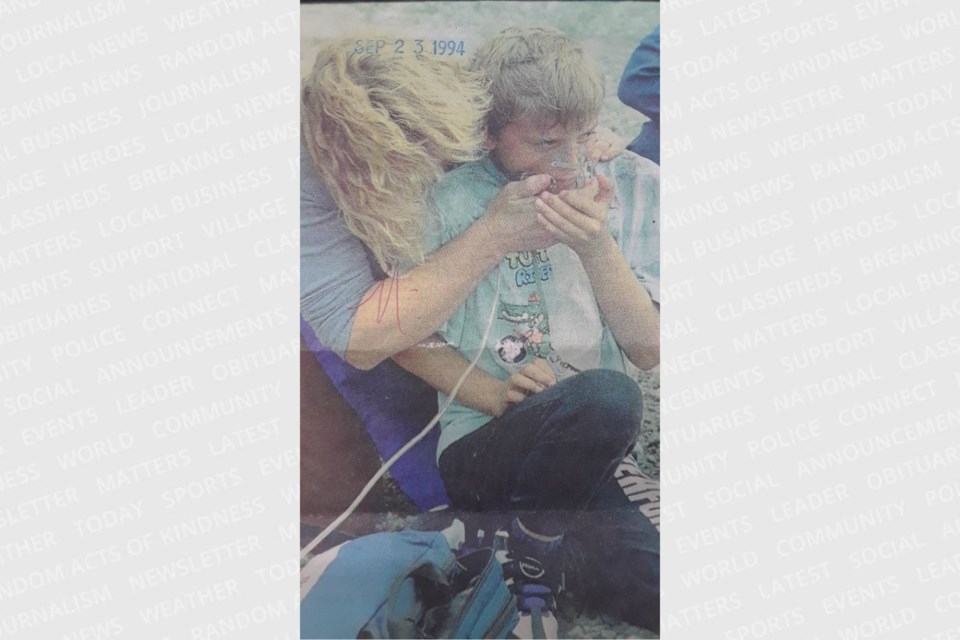From the archives of the Sault Ste. Marie Public Library:
When parents were told their children would participate in a mock disaster they would never have expected that it could turn into the real thing.
Operation Autumn was an emergency drill that went horribly wrong and resulted in 33 children being transported to a hospital on Sept. 22, 1994, for smoke inhalation. Eleven children were admitted to the hospital, some only overnight for observation. Two ended up in intensive care.
The drill was planned to assess the emergency preparedness of first responders and the public school board and involved the use of an artificial explosion from a smoke grenade to make the drill appear more realistic.
However, the device ended up creating an unforeseen amount of smoke in a poorly-ventilated location.
A City Emergency Measures Committee had staged a part of Kiwedin School to have rubble to simulate students and teachers being trapped and injured. Students volunteered to be actors in the simulation, and parents were asked to sign a release form for them to participate.
Once the exercise started, the wing of the school being used quickly became clouded with smoke and adults helped the children outside to fresh air.
According to school board Director of Education Mickey Contini, “the kids were doing their parts beautifully. It took a few minutes for everyone to realize they weren’t acting.”
First responders were expected to be tested on their response times but instead had to leap into action with oxygen.
Parents were naturally concerned. An expert in toxicology from Sick Kids hospital as well as a chemist involved in the design of the smoke grenade were consulted to ensure that the device which had caused the problem did not release any toxic chemicals. They were assured that there would be no long-lasting health effects.
At an evening meeting at the school a few days after the problematic simulation, parent Patti Jennings asked, “Why wouldn’t the people have been informed that a hazardous material was going into the school?”
Officials from the school board, police, fire, ambulance and hospital could not answer the question.
“The parents did not come in here with a great deal of anger," she said. "They want to know what happened and what effects this is going to have on their kids. And we hope there can be a way to prevent a similar occurrence in the future.”
Parents also did not understand why the consent form made no mention of a smoke bomb being used.
Police Chief Barry King who chaired the Emergency Measures Committee that organized the drill announced that he would have a detailed report of the incident and recommendations for the future in four weeks.
He assured that “the committee wasn’t planning on holding anything back or hiding anything.”
Two weeks later, a video of the event which had been filmed by four Bawating High School students for a Television Arts class, was released to the public and a viewing was held at Alexander Henry high school.
The video had some disturbing scenes – there was an abundance of smoke, and children crying, screaming, and coughing. Plans were made by parents to request an independent OPP investigation.
On Oct. 17, 1994, a formal complaint was filed with the Public Complaints Commission which claimed that Chief Barry King and City Police Inspector Bob Davies (the project coordinator) neglected their duty in creating an unsafe situation, did not complete a thorough and prompt investigation after the fact, and provided false information to the media.
A report concerning the ingredients of the smoke canister from the Northern Regional Forensic Laboratory found that there was an “insignificant concentration of carbon monoxide” released and that there would be no long-term effects from zinc oxide or carbon particles. It was noted that the gas canister’s Material Safety Data Sheet was mislabeled by the company and that the ingredients were not as hazardous as initially feared. It was also noted that the device was recommended to be used outdoors.
A 153-page report released by the Emergency Measures Committee on Nov. 1 listed eleven recommendations – the first that imitation smoke and noise devices should no longer be used in future emergency drills and that more detailed and comprehensive planning be required for future simulations.
Concerned parents attended a school board meeting in December and expressed that some children were still experiencing deleterious health effects from the incident such as lung inflammation, shortness of breath, chest pains, headaches, bedwetting, and nightmares.
In February of 1996, the Sault Star reported that Chief Barry King was cleared of all wrongdoing in the matter by the Commissioner of the Ontario Provincial Police.
He found “no evidence of misconduct.” It was decided however that City Police Inspector Bob Davies did “fail to protect the public by creating an unsafe environment and failed to follow appropriate procedures.”
Assertions that a proper investigation had not been done or of false information in the media were considered unfounded by Provincial Police Investigator Chris Coles, who stated that “the use of the smoke and noise grenades did create a risk. The decision to use these devices was an error in judgment.”
Each week, the Sault Ste. Marie Public Library and its Archives provides SooToday readers with a glimpse of the city’s past.
Find out more of what the Public Library has to offer at www.ssmpl.ca and look for more Remember This? columns here
